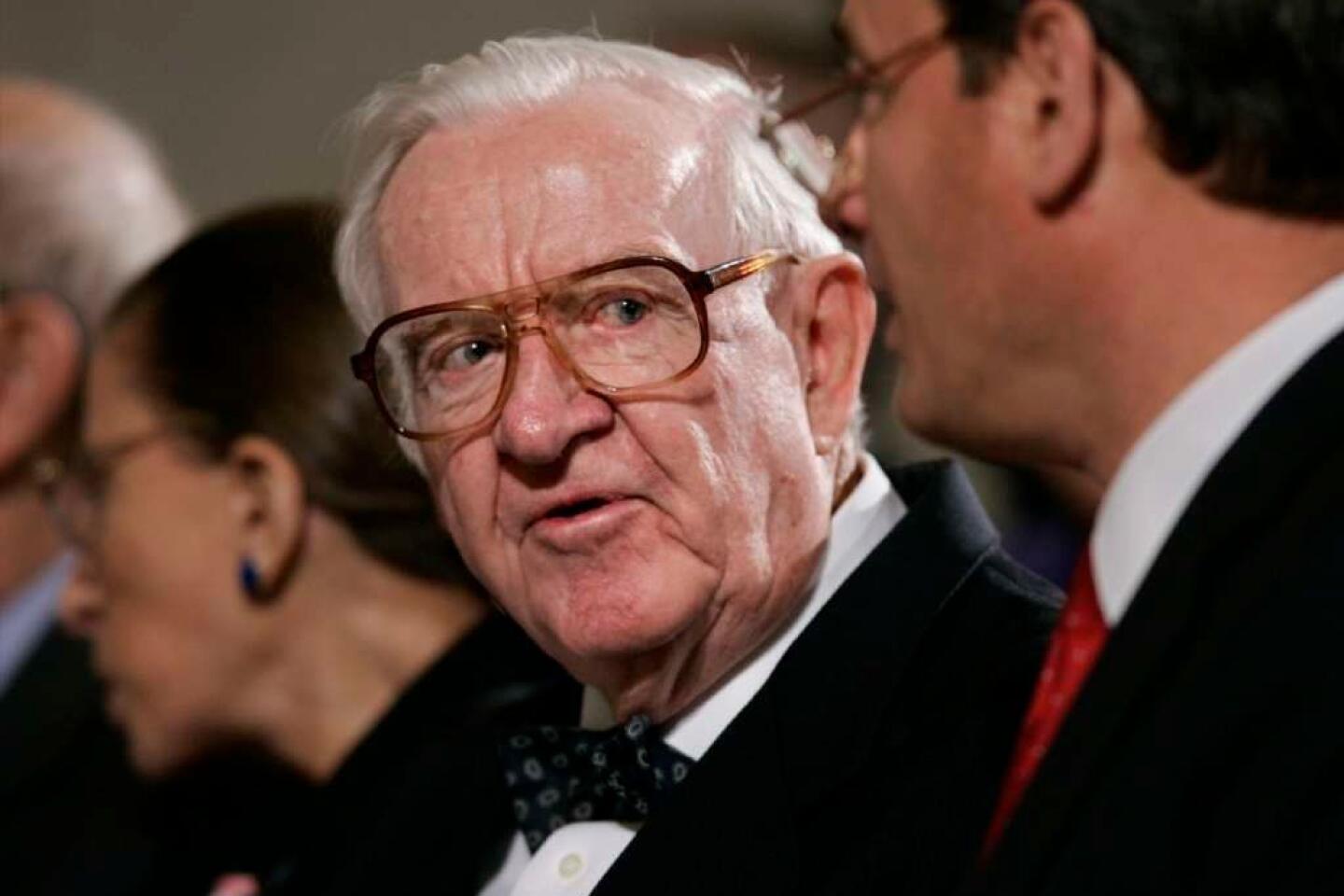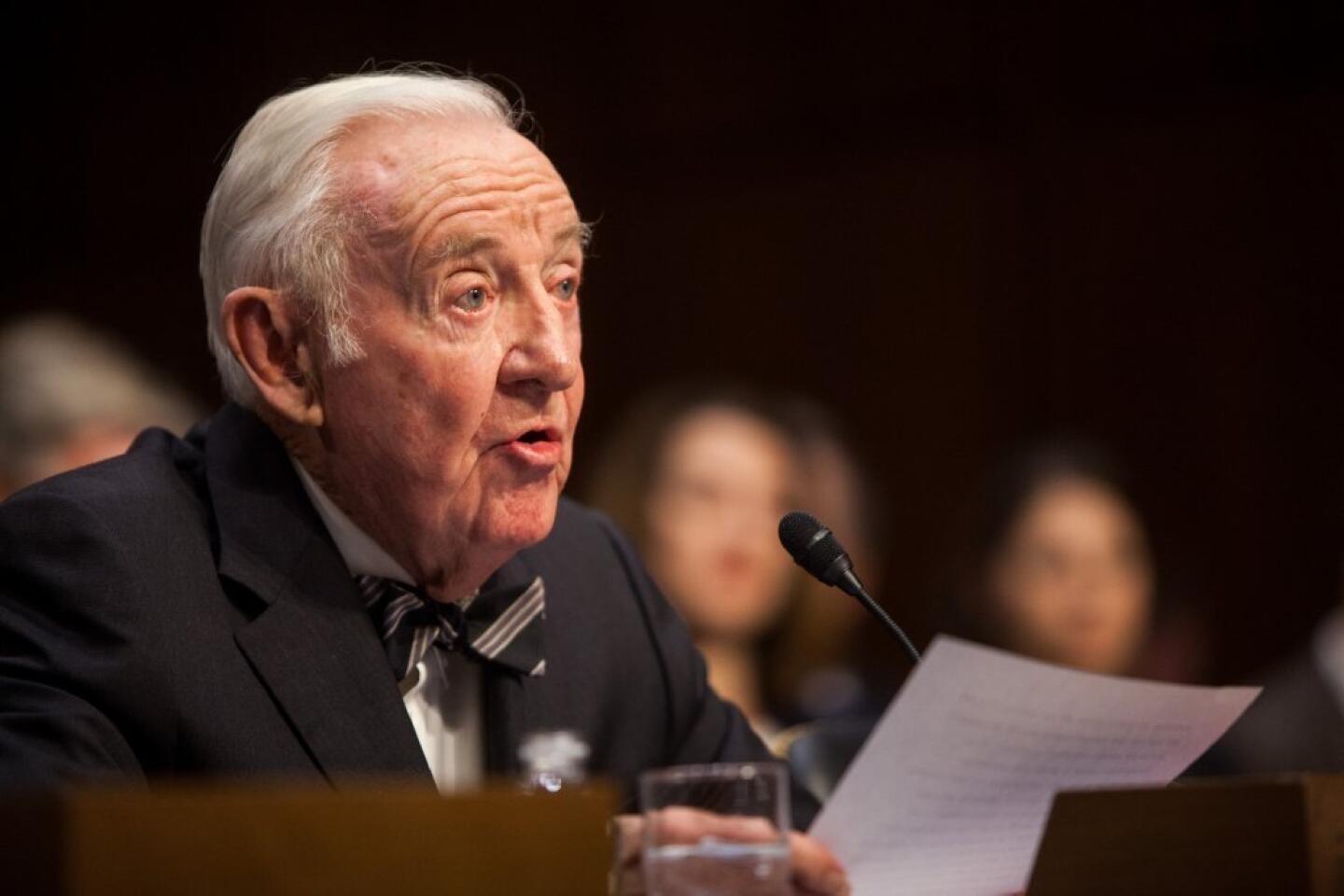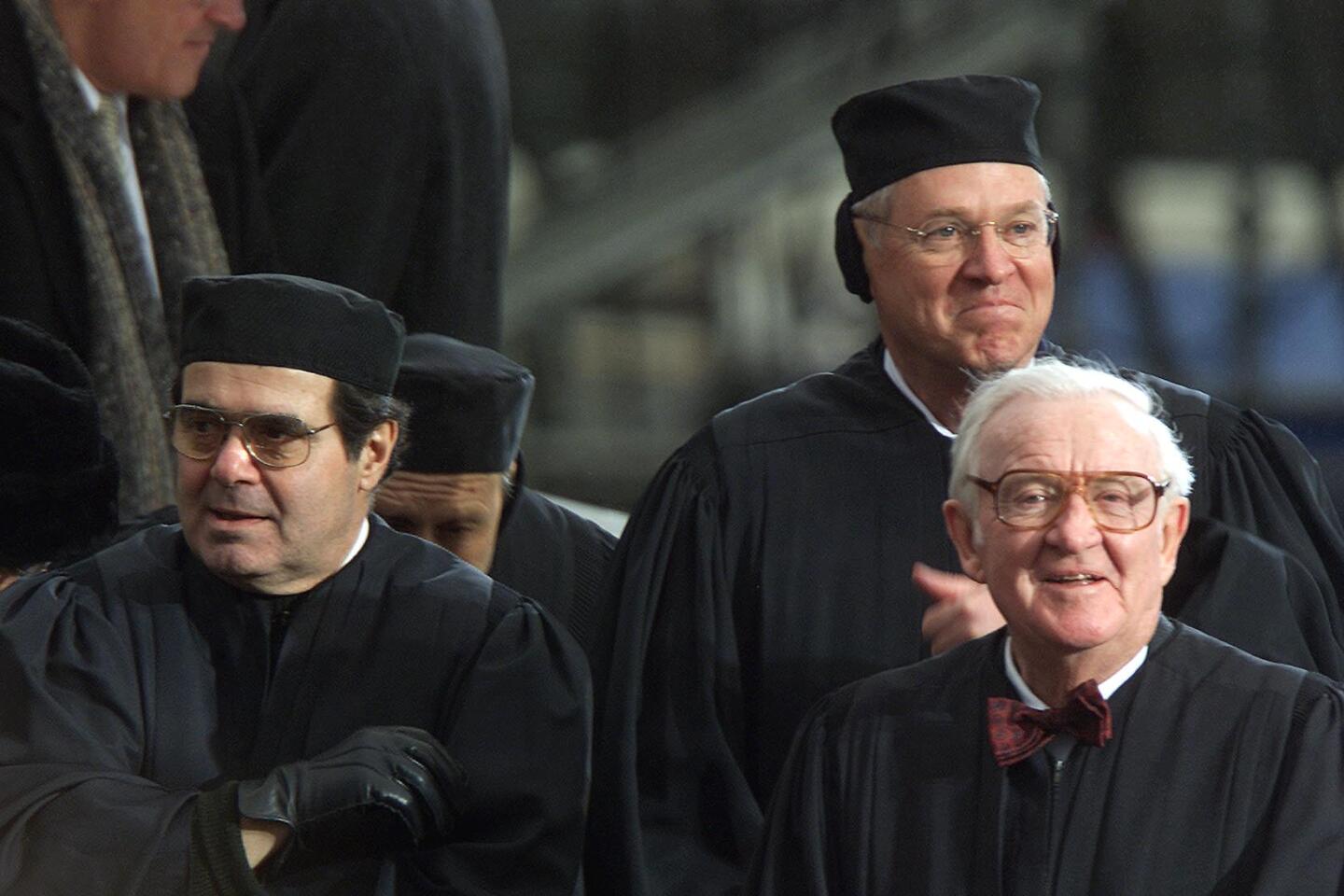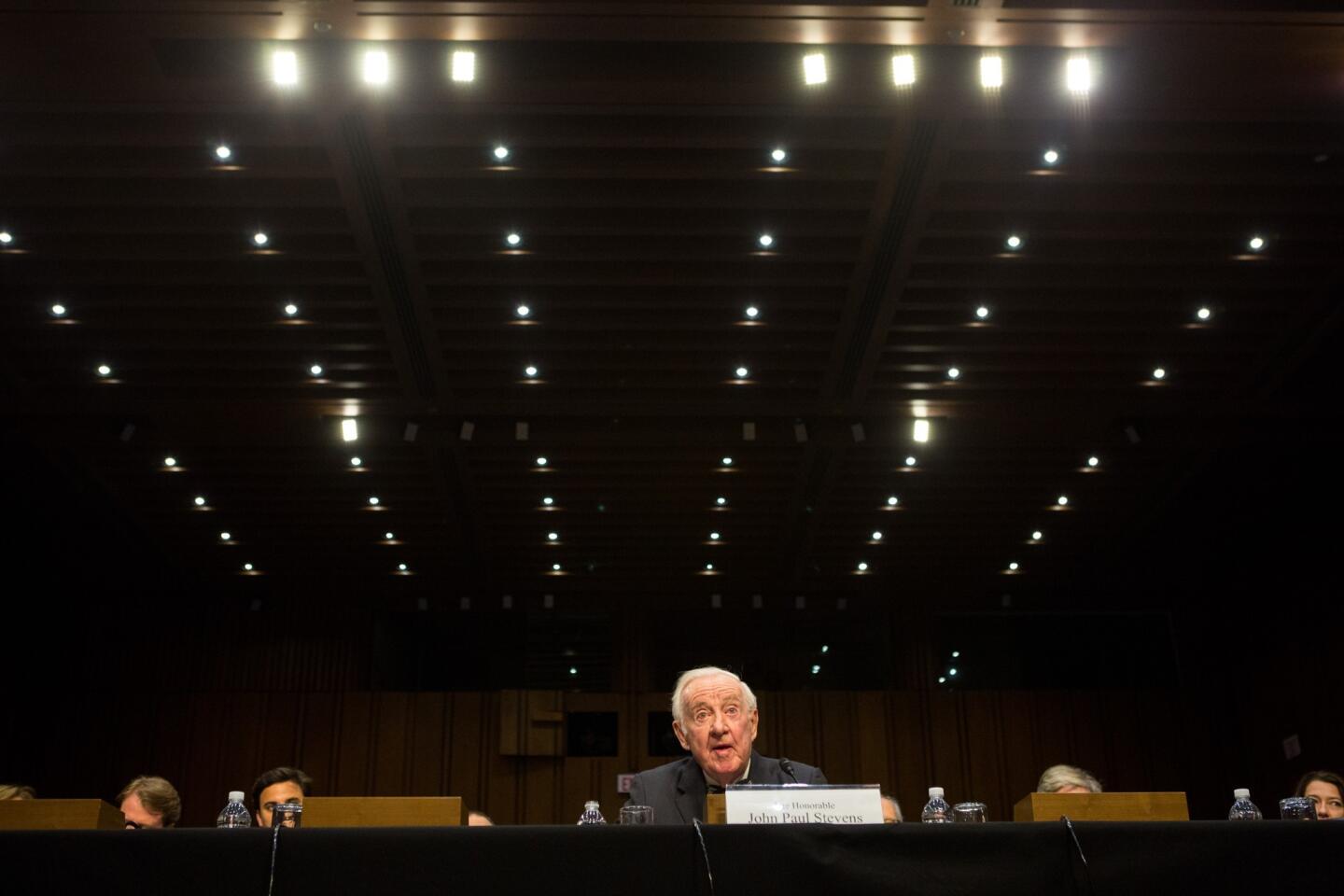John Paul Stevens, retired Supreme Court justice, dead at 99
- Share via
Retired Supreme Court Justice John Paul Stevens, the independent-minded jurist whose bright bow ties and courteous manner symbolized an old-fashioned style of integrity, died Tuesday after suffering a stroke a day earlier. He was 99.
Though he joined the court as a centrist Republican, he emerged in his later years as the leading voice of its liberal bloc.
Stevens retired in 2010 after more than 34 years on the bench, the third-longest tenure in the court’s history. Then-President Obama, sporting a red bow tie in his honor, described him as a “brilliant, non-ideological, pragmatic” justice who “applied the Constitution and the laws of the land with fidelity and restraint.”
His departure also marked the end of an era. He was the last World War II veteran to serve on the court. And as he noted on his last day, he had joined “the brethren” in 1975 at a time when only men served as justices. He was replaced by Justice Elena Kagan, who became the third woman on the nine-member court.
Stevens was also the last of the justices to ascend to the high court before the Senate hearings turned into televised confrontations. He was selected for the high court because he was a truly nonpartisan figure. He had a brief hearing before a Senate panel and was unanimously confirmed in less than two weeks.
He was remarkably vigorous through his 80s and upon his retirement at age 90, he was the second-oldest justice to serve on the high court, surpassed only by the legendary Oliver Wendell Holmes.
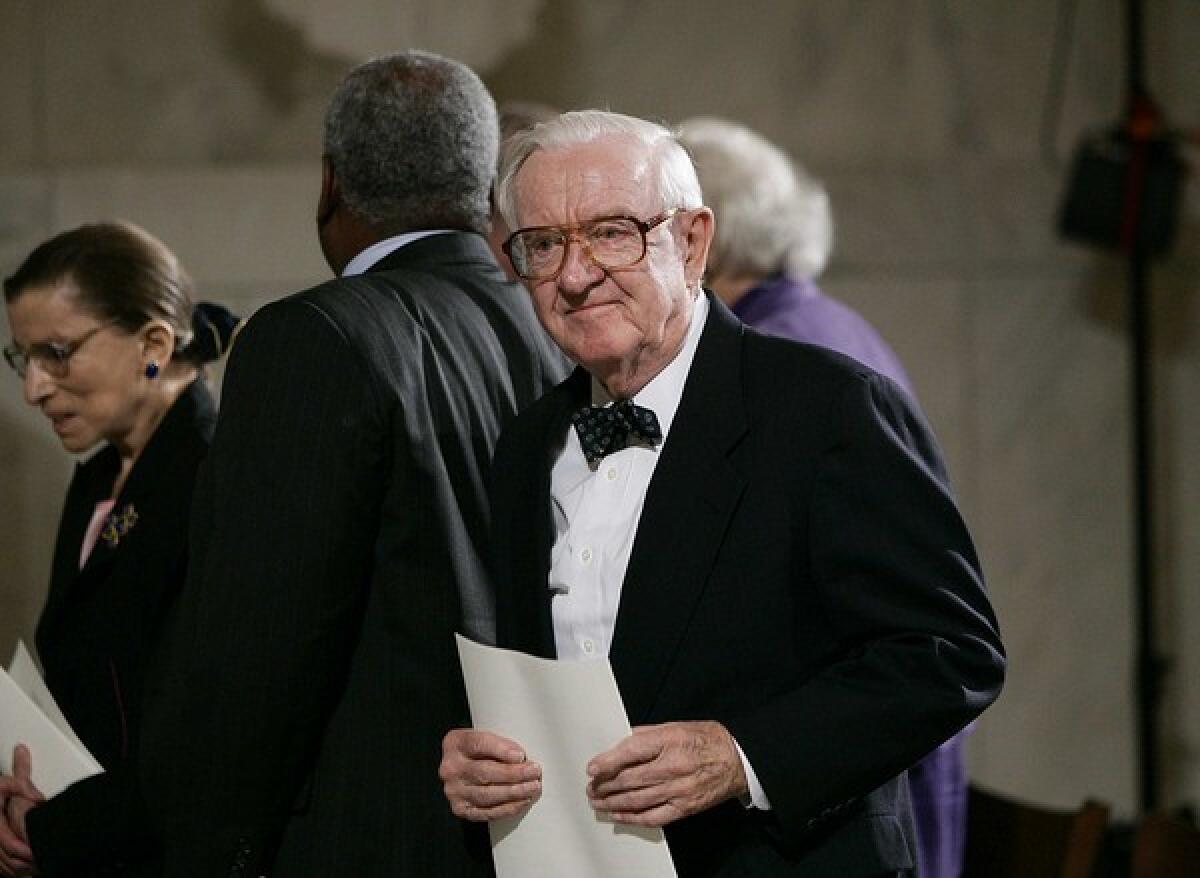
“We will miss your wisdom, your perceptive insights and vast life experience, your unaffected decency and resolute commitment to justice,” Chief Justice John G. Roberts Jr. said on the day of his retirement.
Court scholars and historians debated whether Stevens shifted to the left during his long career or whether the court shifted right. There was evidence for both views.
He was appointed by President Ford, a Midwestern Republican who espoused moderate views on abortion, the environment and religion in the 1970s. And Stevens, like Ford, came to seem out of step with the Republican Party that turned more conservative under President Reagan and the two Presidents Bush.
In his later years, Stevens clashed with the Reagan and Bush appointees to the high court.
“As he saw it, he hadn’t moved so much as the court had moved,” said Diane Marie Amann, a University of Georgia law professor and former clerk to Stevens.
Stevens described himself in an interview as “pretty darn conservative.” But on the major issues that divided the court— including race, abortion, religion, gay rights, gun rights, the death penalty and the environment — Stevens leaned to the liberal side.
Though the court’s liberal wing was in retreat through much of his career, Stevens played a key role in decisions that preserved a woman’s right to abortion, maintained a strict separation of church and state, and put limits on the death penalty and the powers of the president.
He spoke for a unanimous court in the 1997 decision that required President Clinton to respond to a civil lawsuit alleging he sexually harassed an Arkansas state employee, Paula Jones. That ruling, and Clinton’s evasive answers under oath, led to his impeachment by the Republican-controlled House of Representatives the next year.
Although Stevens was much criticized for this opinion, he insisted a chief executive was not immune from being sued for actions that were unrelated to his official duties. He also said the justices had no reason to believe Clinton would not answer the questions truthfully.
President George W. Bush was also on the losing end of several opinions written by Stevens. He led a narrow majority that rejected Bush’s claim that he had the unilateral power to hold and try alleged “enemy combatants” in the war on terrorism. Stevens said the prisoners had a right to challenge their detention before judges.
His best-known dissent came in Bush vs. Gore, the 5-4 ruling that halted the ballot recount in Florida after the 2000 presidential election.
“Although we may never know with complete certainty the identity of the winner of this year’s presidential election, the identity of the loser is perfectly clear. It is the nation’s confidence in the judge as the impartial guardian of the rule of law,” he wrote.
Stevens insisted the high court should have stood back and allowed Florida judges to supervise a recount of the remaining paper ballots that went uncounted by the tabulating machines. Bush’s 537-vote margin in Florida sealed his victory in the electoral college, even though Democrat Al Gore won the nationwide popular vote by 543,000 votes.
Stevens was also a strong defender of the laws that limited the influence of “big money” in politics. “Money is not speech,” he once wrote, but property that can be regulated. He dissented in his last term from a 5-4 decision that held corporations had a free-speech right to spend unlimited sums on election races.
In the courtroom, Stevens was known for his unassuming manner. He asked pointed questions of the lawyers and listened carefully to their answers, but unlike some of his colleagues, he never derided them or cut off those who disagreed with him.
He also was the only justice through most of his career who drafted all of his opinions and dissents. His colleagues usually relied on a clerk to write a first draft of an opinion.
An early riser, Stevens liked to work on opinions at home in Virginia for several hours before driving across the Potomac and to the court. And unlike his colleagues, he and his clerks sifted through all of the more than 7,000 appeals that arrived each year looking for cases that should be reviewed. The eight other justices relied on a pool memo written by a single clerk.
He also may have been the first justice who was a telecommuter. When the court was in recess during the winters — including for long weekends — Stevens flew to Florida. He and his wife had a condominium in Fort Lauderdale, and he blended well with the retirees, playing tennis and golf regularly. But Stevens also spent part of each day drafting and editing opinions and maintaining a steady computer correspondence with his clerks and the court.
His long career on the high court can be divided into two parts. He replaced the fiery New Deal liberal William O. Douglas after a career as a business and anti-trust expert from Chicago.
In his first 15 years on the high court, Stevens was often described as an enigma and quirky. He was neither a staunch liberal nor a reliable conservative. Stevens thought good judges should not follow a predictable ideological pattern, and he took pride in what others saw as his quirky streak.
In the early 1990s, however, the court changed, so did his role. Three of its liberal lions — William J. Brennan, Thurgood Marshall and Harry Blackmun — retired, and they were replaced by more conservative justices. For a brief period, eight of the nine justices were Republican appointees, all but conservative Democrat Byron White.
By 1995, Stevens was second in seniority to conservative Chief Justice William H. Rehnquist. In the court’s deliberations, Stevens played the role of leader of the shrinking liberal bloc. When Rehnquist moved to limit the enforcement of the federal civil rights laws and the desegregation of the schools, Stevens led the dissenters.
He had his share of major wins, however. Stevens spoke for the court when it abolished executions for mentally disabled defendants. He also held together a narrow majority to end the death penalty for juvenile offenders and for crimes other than murder. In 2003, the court endorsed gay rights for the first time and narrowly upheld affirmative action policies for colleges and universities.
Court scholars credited Stevens with helping mold a majority that included moderates Sandra Day O’Connor and Anthony M. Kennedy. “On a court with no true liberals in the ‘60s sense of the word, he’s gotten as much … in terms of left-wing results as anyone could,” University of Chicago law professor Dennis Hutchison said.
Stevens also wrote some highly controversial opinions. In 2005 he spoke for a 5-4 majority that upheld a Connecticut city’s move to seize the homes of several residents, including Susette Kelo, to make way for a redevelopment of its waterfront. Defenders of property rights denounced the decision.
A few months later, Stevens told a lawyers group he regretted the outcome and said the city’s decision was “unwise.” However, he said the law and Constitution permitted cities to condemn land for economic development, so long as the owners were fully compensated.
He also said he regretted a decision that allowed federal officials to seize and destroy marijuana plants in California, despite the state’s medical marijuana initiative. “I have no hesitation in telling you that I agree with the policy choice made by the millions of California voters,” Stevens said in a speech. But he added that “our duty [is] to uphold the application of the federal statute” even if it seemed unwise in this instance.
In 2008, he called for abolishing the death penalty. “State-sanctioned killing is becoming more and more and more anachronistic,” he said, and it is not worth the cost to society to single out a few murderers each year for this punishment.
Stevens was born April 20, 1920, the youngest of four boys in a prominent family from the Hyde Park neighborhood of Chicago, near the University of Chicago. He grew up in the era when Al Capone and his gangland rivals dominated the city. His grandfather J.W. Stevens owned the Illinois Life Insurance Co. and the LaSalle Hotel in the downtown Loop. In the mid-1920s, his father, Ernest, decided to build an even grander hotel facing the lake on Michigan Avenue.
John Paul Stevens was 7 when the Stevens Hotel opened for business. With 28 floors and 3,000 rooms, it was hailed as world’s largest hotel. Stevens met aviation pioneers Charles Lindbergh and Amelia Earhart when they visited the hotel.
In 1932, he saw New York Yankees slugger Babe Ruth hit the famous “called shot” home run at Wrigley Field during the World Series against the Cubs. That year, he also watched Franklin D. Roosevelt accept the Democratic Party’s nomination for president.
The Great Depression hit hard in those years, and travel and tourism plummeted. His family lost the Stevens Hotel in bankruptcy.
In 1933, Stevens’ father and uncle were indicted on embezzlement charges. They had transferred money from the insurance company to the hotel in hopes of keeping it afloat. At the depth of the Depression, business owners were none too popular, and the indictments were major news in Chicago. His uncle shot himself at home before the trial, and his father, Ernest, was convicted.
A year later, however, the Illinois Supreme Court unanimously reversed the conviction and ruled the transfer of funds between the two family-owned companies did not amount to embezzlement.
Although his family lost its fortune, the landmark hotel survived. It is now known as the Hilton Chicago. Stevens declined to say much about his father’s ordeal, except that it made him aware at a young age that the criminal justice system “can misfire sometimes.”
In 1941, he graduated as an English major from the University of Chicago, and on Dec. 6, he enlisted in the Navy. The next day, a Japanese attack from the air destroyed the U.S. naval base at Pearl Harbor in Hawaii and launched World War II.
Stevens served as an intelligence officer in the Pacific and worked on breaking the radio codes of the Japanese. He was awarded a Bronze Star for his work on the code-breaking team that was credited in 1943 with the shooting down of Adm. Isoroku Yamamoto, the mastermind of the attack on Pearl Harbor.
When the war ended, Stevens returned to Chicago and used the GI Bill to attend law school at Northwestern University. He graduated first in his class in 1947 and won a clerkship at the Supreme Court with Justice Wiley Rutledge.
A year earlier, Rutledge had filed a long and powerful dissent when the court upheld Gen. Douglas MacArthur’s drive to execute Japanese generals for the atrocities committed by their troops. Rutledge protested the conviction of Gen. Tomoyuki Yamashita because he was cut off from his troops in the Philippines when they went on murderous rampage.
Nearly 60 years later, Justice Stevens would cite the Rutledge dissent in his opinion for the court in Hamdan vs. Rumsfeld in which he extended the Geneva Convention’s standards of fairness to military trials.
After returning to Chicago, Stevens practiced law and was recognized as an expert in antitrust. In 1969, a court scandal helped propel him to high office. A local gadfly accused the Illinois Supreme Court of corruption, and after the charges gained traction in the newspapers, Stevens was named to lead a state investigation. He took no pay for the work, but within six weeks he had investigated the allegations, taken testimony from all the participants and submitted a final report. Two justices resigned in its wake for having secretly taken bank stock.
Stevens was widely praised for his performance and his sense of integrity, and a year later, President Nixon named him to the U.S. Court of Appeals in Chicago. Five years later, he got the call to go to the Supreme Court.
He never cut his ties to Chicago, however. And at age 85, he got an opportunity he had dreamed of as a boy watching the Cubs. He took the mound at the Wrigley Field and threw the ceremonial first pitch right over the plate.
More to Read
Get the L.A. Times Politics newsletter
Deeply reported insights into legislation, politics and policy from Sacramento, Washington and beyond. In your inbox three times per week.
You may occasionally receive promotional content from the Los Angeles Times.

